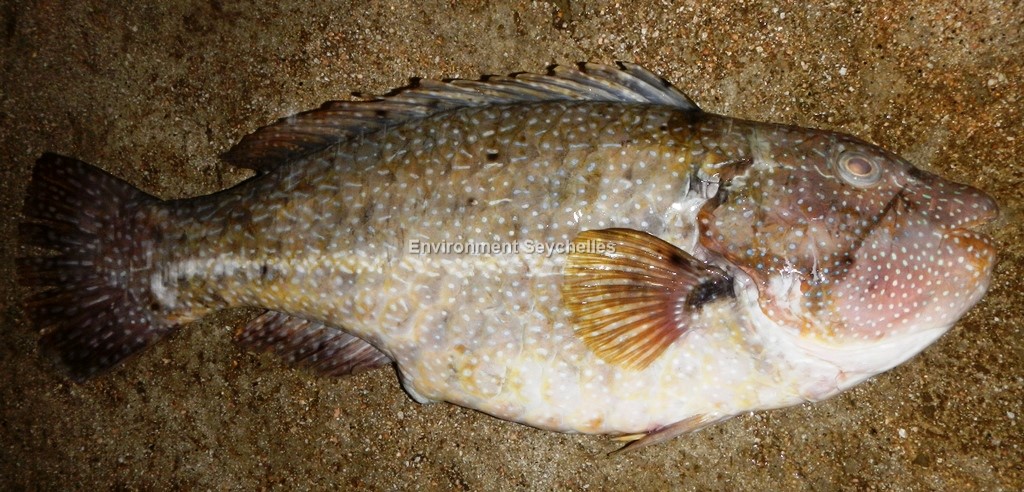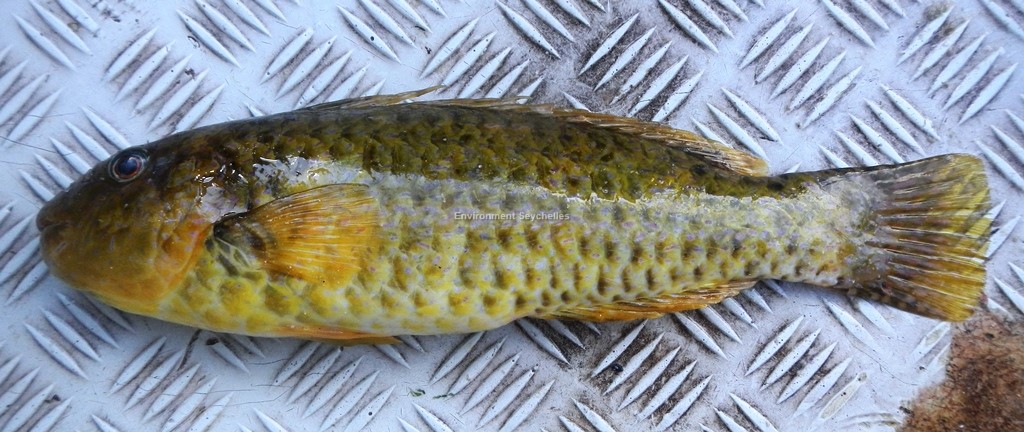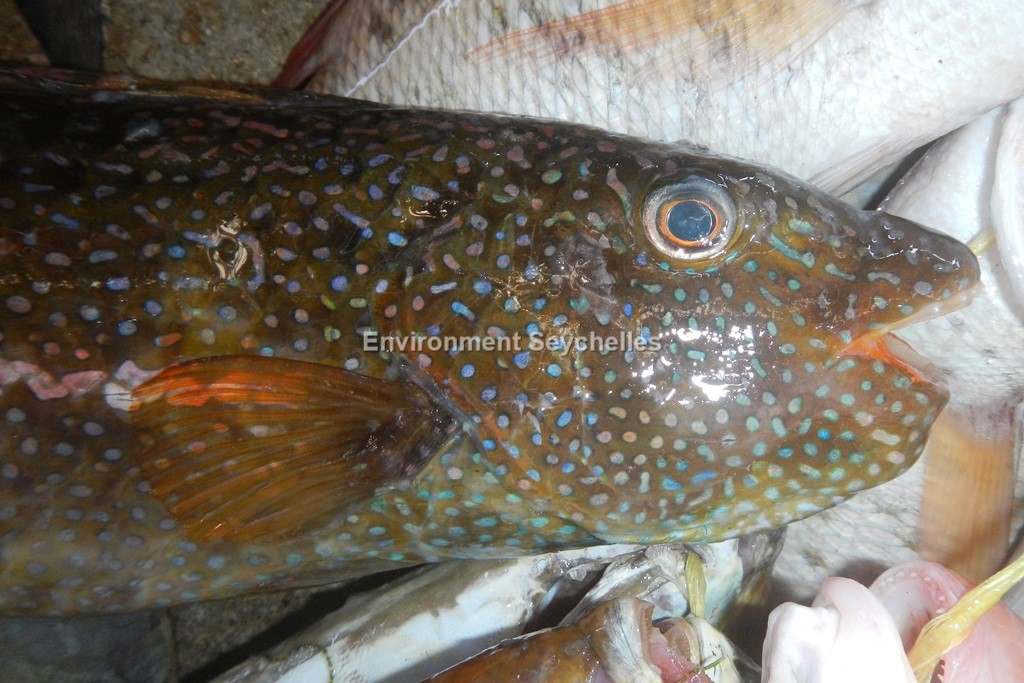Description:
Dorsal spines: 9; Dorsal rays: 10; Anal spines: 3; Anal rays: 9.
Relatively small typically slim-bodied (large male specimens can become full-bodied) parrotifsh. Blunt rounded head. Unique narrow dental plates composed
of numerous small teeth. The upper jaw teeth are enclosed by the lower when the mouth is closed. Median predorsal scales 4 (occasionally 3). Caudal fin
truncate to slightly rounded.
Colour. Body greenish with pale and dark brown scales providing marbled effect, paler below. Eye with yellow orange iris and outer green ring. Males with
small blue spots on head, body and anal and caudal fins; and a regular white stripe on body.
Size:
Maturity: Lm unknown. Range unknown. Max Length: 35 cm TL.
(Females mature at approximately 17 cm – Heemstra & Heemstra, 2004).
Habitat and Ecology:
Found in sheltered bays, harbours and lagoons with seagrass beds and shallow areas with thick algal growth (depth 1-15 m). Marbled Parrotfish usually
occur in small groups. Unlike other parrotfishes, males and females look similar and do not change sex. Larvae of this species is associated with drifting
algae. It feeds on seagrasses and algae.
Fishery Status:
This species is not protected or subject to fishery regulations. It is caught in the fish trap fishery, but is an uncommon component of the catch off the
north of Mahe where it was formerly abundant. This has been associated with extensive loss of coastal seagrass habitat to land reclamation. It still
occurs in larger numbers further south on the east and west coasts of Mahe. It is also occasionally caught in large numbers in nets.
Notes:
References:
Australian Museum (2019). Marbled parrotfish, Leptoscarus vaigiensis. https://australianmuseum.net.au/learn/animals/fishes/blue-spotted-parrotfish-leptoscarus-vaigiensis-quoy-gaimard-1824/ (19/03/19).
Bray, D. J. Leptoscarus vaigiensis in Fishes of Australia, http://fishesofaustralia.net.au/home/species/398 (19/03/19).
Choat, J.H. et al. (2012). Leptoscarus vaigiensis. The IUCN Red List 2012: http://dx.doi.org/10.2305/IUCN.UK.2012.RLTS.T190756A17777316.en. (19/03/19).
Froese, R. & D. Pauly. (Eds.) (2018). FishBase. https://www.fishbase.de/summary/Leptoscarus-vaigiensis.html (19/03/19).
Heemstra, P. & Heemstra, E. (2004). Coastal Fishes of Southern Africa. NISC SAIAB. ISBN: 1-920033-01-7.
Lieske, E. & Myers, R. (2002). Coral Reef Fishes. Indo-Pacific and Caribbean. Revised edition. Princeton University Press. ISBN 0-691-08995-7
Nevill, J. (2013). A Species Identification Guide for Commonly Caught Fish in the Seychelles Near-Shore Artisanal Fishery. GOS/UNDP/GEF.
Citation:
Nevill, J.E.G. (2019). Leptoscarus vaigiensis, Marbled parrotfish. Seychelles Seatizens. www.seatizens.sc. https://seatizens.sc/species/leptoscarus-vaigiensis-quoy-gaimard-1824/ (edited 15/08/22).




Im grateful for the article post.Thanks Again. Fantastic.
Thank you ever so for you blog article.Really looking forward to read more. Will read on…
Great blog. Awesome.
Enjoyed every bit of your post.
I value the blog.Really thank you! Really Cool.
I cannot thank you enough for the blog.Really thank you! Really Cool.
Im grateful for the blog.Really looking forward to read more. Keep writing.
I think this is a real great blog article. Cool.
I cannot thank you enough for the blog. Keep writing.
Very good article post. Really Great.
Really enjoyed this blog post.Much thanks again. Great.
Muchos Gracias for your article.Really looking forward to read more. Cool.
Really informative article.Really looking forward to read more. Fantastic.
Appreciate you sharing, great post. Much obliged.
Awesome article.Much thanks again. Awesome.
A round of applause for your blog post.Really thank you! Much obliged.
Really appreciate you sharing this article.Really looking forward to read more.
Thanks again for the blog article.Really looking forward to read more.
Appreciate you sharing, great blog article. Great.
wow, awesome post. Really Great.
Really informative blog.Thanks Again. Much obliged.